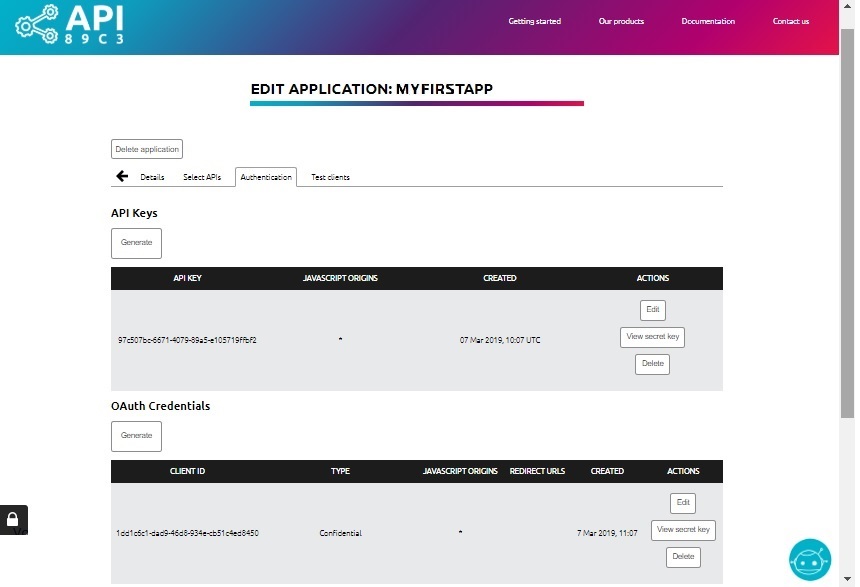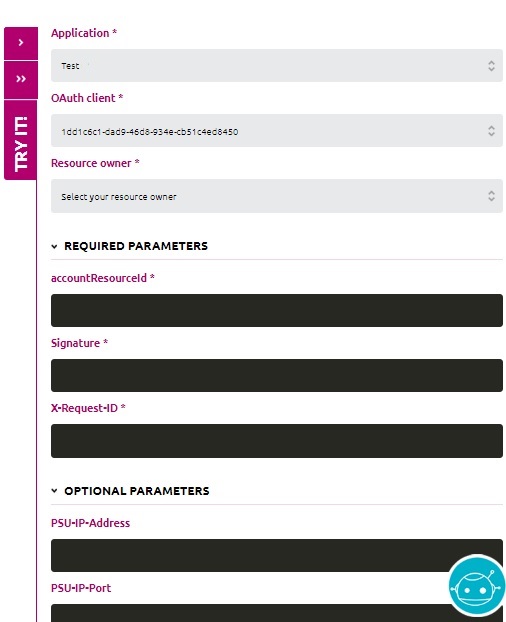Test the API in Sandbox Try-it
➤ Global overview
➤ Version 1.4.2
As of July 8, 2020, try-it will only be possible for version V1.4.2.
If you have already applied for GoLive, then you must create a new application and select the new STET API V1.4.2.
If you have NOT made a GoLive request, you can :
- either modify your existing application to associate it with the new STET V1.4.2 API
- either create a new application, then select the new STET V1.4.2 API
➤ Process
When you connect on 89C3 API portal, you can
call the Account information API through a form in which you will specify the application, the access / authentication token
then, you enter the method parameters that you want to test (either headers, either body) the ones with a star are mandatory parameters
Once the parameters entered, you can process the request : either you will get a result, either you will get an error.
For the GET /accounts/transactions and GET /accounts/balances methods, you must first execute the GET /accounts request in order to retrieve the current accounts list and the linked delayed debit cards. It will allow you to get the needed "ressourceId" for using these methods.
The data used to make the test in Try-It must come from the provided personas (see the use case "Test data").
The user can thus choose a specific profile for his test so as to better apprehend the obtained results.
If needed, to make the results easier to read, there will be a navigation with links to the different result pages (see examples in "Get accounts list" and "Get transaction history" use cases).
➤ Oauth2 token generation screen preview

This screen is accessible when editing the application (dsp2 in our case) ; it allows to generate or edit an Oauth2 token that will be selected in the Try-It execution form.
➤ Try-It execution form screen preview

➤ Try-It parameters for every Account information API method
For the body data type parameters you can copy paste the examples (left part of the screen) in the form (right part of the screen) by changing only the specific values of the chosen customer.
➤ Common parameters to every Account information API method
| Parameter | Description | Data type | Parameter type | Mandatory |
|---|---|---|---|---|
| Authorization | Access token to provide as header | String | Header | Yes |
| PSU-IP-Address | IP Address of the customer's terminal when connecting to the TPP Required if the client is connected but not filled in for a batch access | String | Header | No |
| PSU-IP-Port | IP Port of the customer's terminal when connecting to the TPP | String | Header | No |
| PSU-HTTP-Method | HTTP Method used for the most relevant customer’s terminal request to the TTP | String | Header | No |
| PSU-Date | Timestamp of the most relevant customer’s terminal request to the TTP | String | Header | No |
| PSU-GEO-Location | The forwarded Geo Location of the corresponding HTTP request between customer and TPP if available. | String | Header | No |
| PSU-User-Agent | Header “User-Agent” header field sent by the customer's terminal when connecting to the TPP | String | Header | No |
| PSU-Referer | “Referer” header field sent by the customer's terminal when connecting to the TPP. It should be noted that in the previous specifications of the RFC 1945 it was recommend the name "referer" (misspelled). The name "referrer" can be used with the risk of not being understood. | String | Header | No |
| PSU-Accept | “Accept” header field sent by the customer's terminal when connecting to the TPP. | String | Header | No |
| PSU-Accept-Charset | “Accept-Charset” header field sent by the customer's terminal when connecting to the TPP. | String | Header | No |
| PSU-Accept-Encoding | “Accept-Encoding” header field sent by the customer's terminal when connecting to the TPP. | String | Header | No |
| PSU-Accept-Language | “Accept-Language” header field sent by the customer's terminal when connecting to the TPP. | String | Header | No |
| PSU-Device-ID | UUID (Universal Unique Identifier) for a device used by the customer, if available. The UUID identifies a device or the installation of a device dependant application. In the case of an installation identification this ID needs to be persistant until the device removal. | String | Header | No |
| Digest | Digest of the body | String | Header | No |
| Signature | http-signature of the request (cf. https://datatracker.ietf.org/doc/draft-cavage-http-signatures/) . The keyId part of the header should have the following format keiId = "SN = XXX, CA = YYYYYYYYYYYYYYYYYYYY". "XXX" is the serial number in hexadecimal without any prefix (such as 0x, of the QSEAL certificate whose private key was used for the signature of it. "YYYYYYYYYYYYYYYY" is the DN issuer, the full name of the certification authority that issued this HTTP400 certificate that will be returned by the server in the case of an invalid or missing signature. | String | Header | Yes |
| X-Request-ID | Correlation header to be set in a request and retrieved in the relevant response. | String | Header | Yes |
➤ Parameter specific to the GET /accounts/{}/balances method
| Parameter | Description | Data type | Parameter type | Mandatory |
|---|---|---|---|---|
| accountResourceId | Resource identification used as the main criteria in the request. It comes with the result of the "GET /accounts" dans la rubrique "ressourceId" request :
| String | Path | Yes |
➤ Parameters specific to the GET /accounts/{}/transactions method
| Parameter | Description | Data type | Parameter type | Mandatory |
|---|---|---|---|---|
| accountResourceId | Resource identification used as the main criteria in the request. It comes with the result of the "GET /accounts" dans la rubrique "ressourceId" request :
| String | Path | Yes |
| dateTo | Exclusive maximal imputation date of the transactions. Transactions having an imputation date equal to this parameter are not included within the result. | String | Request | No |
| dateFrom | Inclusive minimal imputation date of the transactions. Transactions having an imputation date equal to this parameter are included within the result. | String | Request | No |
| afterEntryReference | Specifies the value on which the result has to be computed. Only the transaction having a technical identification greater than this value must be included within the result | String | Request | No |